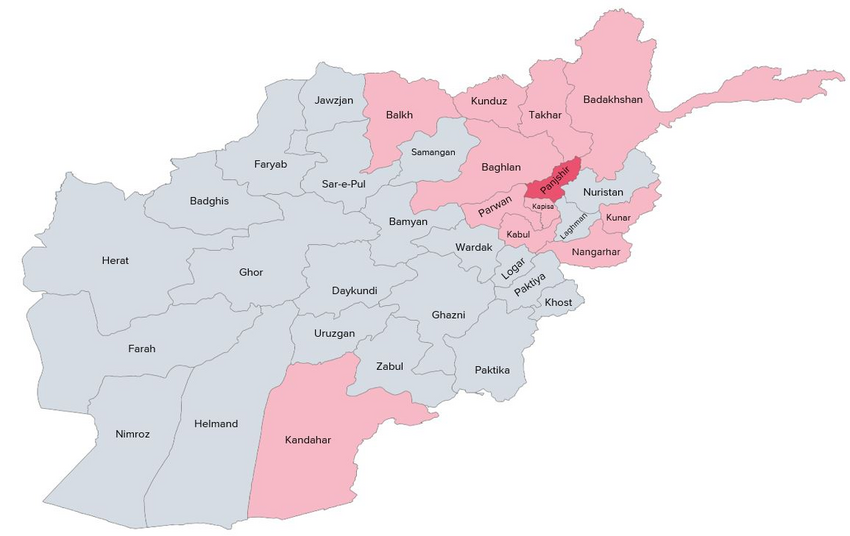Serious and individual threat to a civilian’s life or person by reason of indiscriminate violence in situations of international or internal armed conflict
GUIDANCE NOTE
Last update: January 2023
Armed conflict
Two main parallel internal armed conflicts, in the meaning of Article 15(c) QD, take place in the territory of Afghanistan:
- between the Taliban de facto government and the NRF; and
- between the Taliban de facto government and the ISKP.
Confrontations and incidents in relation to these conflicts primarily affect certain provinces and cities in Afghanistan, however, the situation remains fluid.
Civilian
Article 15(c) QD applies to a person who is not a member of any of the parties to the conflict and is not taking part in the hostilities, potentially including former combatants who have genuinely and permanently renounced armed activity. The applications by persons under the following profiles should be examined carefully. Based on an individual assessment, such applicants may be found not to qualify as civilians under Article 15(c) QD.
For example:
- Taliban and affiliated armed groups, e.g. Haqqani network and Al-Qaeda
- NRF and other armed groups opposing the Taliban
- ISKP
Indiscriminate violence
The map below summarises and illustrates the assessment of indiscriminate violence per province in Afghanistan (Figure 1). This assessment is based on a holistic analysis, including quantitative and qualitative information for the reference period (15 August 2021 – 31 October 2022). Up-to-date country of origin information should always inform the individual assessment.
Figure 1. Level of indiscriminate violence in Afghanistan (based on information up to 31 October 2022).

|
|
The level of indiscriminate violence is high and, therefore, a lower level of individual elements is required in order to substantiate subsidiary protection needs under Article 15(c) QD. |
|
|
|
|
|
Indiscriminate violence is also taking place, however not at a high level. Moreover, a significant proportion of the civilian fatalities in these provinces is considered to be the result of security incidents of a targeted nature. A high level of individual elements is required in order to substantiate subsidiary protection needs under Article 15(c) QD. |
|
|
|
|
|
There is currently no real risk for a civilian to be personally affected by indiscriminate violence within the meaning of Article 15(c) QD. |
|
|
No province in Afghanistan is currently assessed to reach such an exceptionally high level of violence that ‘mere presence’ on the territory would be considered sufficient in order to establish a real risk of serious harm under Article 15(c) QD.
The provinces of Afghanistan are categorised as follows:
|
|
Panjshir is currently the province most affected by indiscriminate violence. It is assessed that the level of such violence in the province is high and, therefore, a lower level of individual elements is required in order to substantiate subsidiary protection needs under Article 15(c) QD. |
|
|
Indiscriminate violence is also taking place in the provinces of Badakhshan, Baghlan, Balkh, Kabul, Kandahar, Kapisa, Kunar, Kunduz, Nangarhar, Parwan, Takhar. However, this violence does not reach a high level. Moreover, a significant proportion of the civilian fatalities in these provinces is considered to be the result of security incidents of a targeted nature. Therefore, a high level of individual elements is required in order to substantiate subsidiary protection needs under Article 15(c) QD. |
|
|
In the remaining provinces of Afghanistan, including Badghis, Bamyan, Daykundi, Farah, Faryab, Ghazni, Ghor, Helmand, Herat, Jawzjan, Khost, Laghman, Logar, Nimroz, Nuristan, Paktika, Paktiya, Samangan, Sar-e Pul, Uruzgan, Wardak, Zabul, it is assessed that there is currently no real risk for a civilian to be personally affected by indiscriminate violence within the meaning of Article 15(c) QD. This may be because the criteria for an armed conflict within the meaning of this provision are not met, because no indiscriminate violence is taking place, or because the level of indiscriminate violence is so low, that in general there would be no real risk for a civilian to be affected by it. |
Serious and individual threat
In the context of the ‘sliding scale’, each case should be assessed individually, taking into account the nature and intensity of the violence in the area, along with the combination of personal circumstances present in the applicant’s case. The following are examples of circumstances which may impact the ability of a person to assess and/or avoid risks related to indiscriminate violence in a situation of an armed conflict:
- age
- gender
- health condition and disability, including mental health issues
- economic situation
- knowledge of the area
- occupation and/or place of residence
- etc.
Threat to life or person
Some of the commonly reported types of harm to civilians’ life or person in Afghanistan include killings, injuries, abductions, disabilities caused by explosive remnants of war, etc. A real risk of such serious harm would qualify a threat to a (civilian’s) life or person in accordance with the provision of Article 15(c) QD.
Nexus
The interpretation of the causation ‘by reason of’ may not be limited to harm which is directly caused by the indiscriminate violence or by acts that emanate from the actors in the conflict. To a certain extent, it may also include the indirect effect of indiscriminate violence in situations of armed conflict. As long as there is a demonstrable link to the indiscriminate violence, such elements may be taken into account in the assessments, for example: widespread criminal violence as a result of lawlessness, destruction of the necessary means to survive, destruction of infrastructure, denial of or limited access of humanitarian aid. Armed clashes and/or road blockages can also lead to food supply problems that cause famine or to limited or no access to healthcare facilities in certain regions in Afghanistan.
